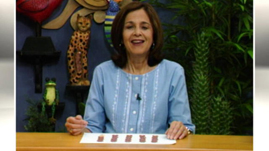Teachers' Domain - Digital Media for the Classroom and Professional Development
User: Preview



Señora Alicia invites students to count with her. She reviews the numbers up to 20 by counting 19 bears and Goldilocks or Ricitos de Oro (19+1=20).
This video was adapted from ¡Arte y más!, originally produced by KET as a complete curriculum for primary-level Spanish based on arts and humanities content. Spanish teachers can use these resources in traditional or online instruction to reinforce language acquisition and teach about Latin American culture.
Los Numeros Maya Coloring Page (Document)
Counting
Counting is one of the basic skills in any language, and it is the root of science and astronomy, which was used by the indigenous groups of Central America—the Mayans and the Aztecs—to create some of the most precise calendars in the world. This achievement ranks these Central American cultures with the great civilizations of the ancient world, such as Egypt, China, and Rome. Calendars were used to determine planting of crops, but also religious rituals and ceremonial events. It is easy to see why the Mayans and Aztecs depended on numbers in order to keep track of their elaborate calendar!
The Mayan numbers consist of three symbols: a shell that represented the abstract concept “zero,” a dot that represented one unit, and a bar that represented five units. These numbers would be stacked vertically, rather than horizontally as with our numbering system. For example, the number four would be represented by four dots, the number nine with one bar and four dots on top of the bar, the number 14 with two stacked bars and the four dots on top, and the number 19 with three stacked bars and four dots on the top. As the number gets larger it grows taller.
Mayan numbers are also unusual because they are vigesimal numbers based on units of 20, rather than decimal numbers, which are based on units of 10. This means the number 20 would be written with a dot in the space for the 20 units, over a shell for zero in the single units. The number 30 would be one dot in the place for the 20 units over two bars in the place for the single units. The number 40 would be written with two dots over a shell. The third place holder would represent the 400s. So the number 493 would be represented by one dot on top (400x1), over four dots (20x4), over three dots over two bars (13x1), for the complete number (400+80+13=493).
Teaching Tips
Activity 1: Counting shells
Vocabulary
contar, conchas (shells), diecinueve, veinte
For this activity, you will need:
• shells made out of foam in different colors, glue, a white piece of construction paper
Directions
Activity 2: How many beans are there in the jar?
Vocabulary
contar, frijoles (beans), diez, veinte
For this activity, you will need:
• three glass jars, one with 20 beans, one with 10 beans, one with 19 beans
Directions
 Loading Standards
Loading Standards